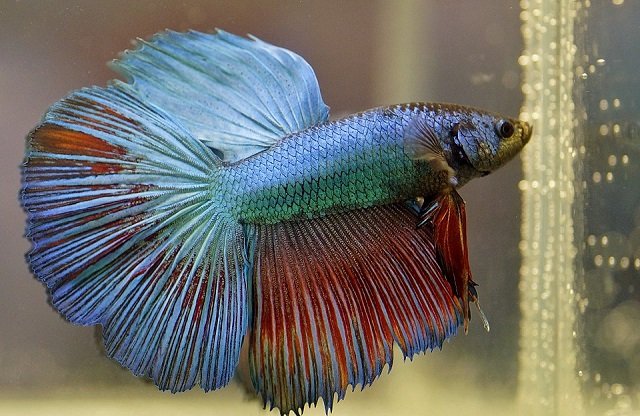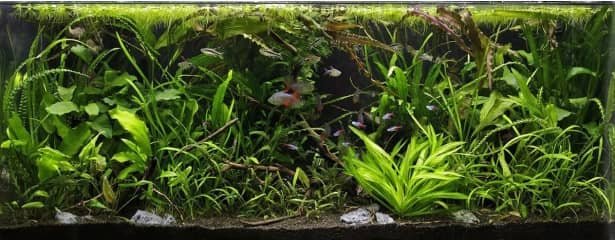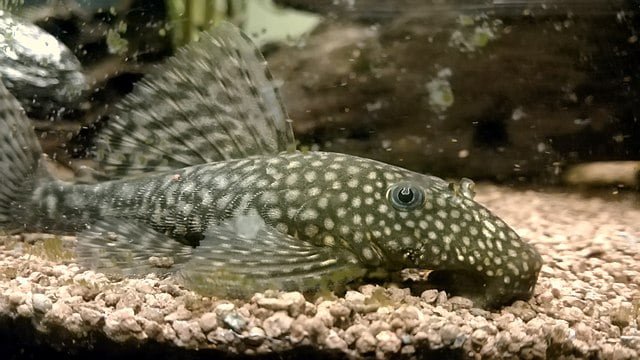Otocinclus, affectionately known as “Otos,” are small freshwater catfish native to South America that have earned a special place in the hearts of aquarists worldwide. Belonging to the Loricariidae family, these tiny yet “hardworking” fish are famous for their voracious appetite for certain types of algae, making them a popular and functional addition to many planted and community aquariums. However, their small size and peaceful nature often conceal a sensitivity that requires specific and attentive care.
Many species of Otocinclus are distributed through the aquarium trade; however, supply still depends on wild-caught specimens since successful captive breeding has not yet been achieved.
This article is a comprehensive guide designed to cover all essential aspects of Otocinclus catfish care. From species selection and ideal tank setup to diet, behavior, reproduction, and troubleshooting common issues, we will explore in-depth how to keep these fascinating Otocinclus fish healthy and happy.
Otocinclus Fish Taxonomy
Otocinclus belong to a genus of catfish (Siluriformes) within the vast Loricariidae family, which includes 19 species of interest to aquarium enthusiasts due to their algae-eating habits and peaceful temperament. This family also includes other popular “plecos” and armored catfish.
- Kingdom: Animalia
- Phylum: Chordata
- Class: Actinopterygii
- Order: Siluriformes
- Family: Loricariidae
- Tribe: Hypoptopomatini
- Genus: Otocinclus
- Scientific Names: Otocinclus affinis (Macrotocinclus affinis), O. hoppei, O. vestitus, O. vittatus, O. cocama, and O. macrospilus.
- Common Names in Spanish: Otocinclus, otocinclo, limpiafondos, pez oto
- Common Names in English: “Otto fish,” “Oto fish,” “Otocinclus Catfish”
Otocinclus Fish Characteristics
One of the most notable characteristics of Otocinclus is their small size. Most species commonly available in the aquarium hobby vary in size depending on the species, ranging from 2.4 cm (O. tapirape) to 5.5 cm (O. flexilis). Female Otos are larger and wider than males, and their average lifespan in captivity is 3 to 5 years. This small size makes Otocinclus suitable even for moderately sized aquariums.
These fish have a typical sucker-shaped mouth like other loricariids, adapted for scraping surfaces. Their bodies are elongated and somewhat flattened ventrally, covered by bony plates (scutes) instead of scales, providing a kind of armor. Their coloration varies by species, but they generally exhibit shades of brown, gray, or pale gold on the dorsal side, with a lighter, often white or yellowish belly. A common characteristic in many species, such as Otocinclus vittatus, is a distinctive dark horizontal stripe running along the body from the snout to the caudal fin.
Otocinclus fish differ from other catfish species by their rows of armor plates along their bodies, which protect them from other fish and rough surfaces (Wood, 2022). Additionally, depending on the species, Otocinclus can be found in different colors and patterns; however, the most common colors include muted shades of green, brown, and gray, with a darker horizontal stripe on their flanks (Edmond, 2022).
Stay Always Informed
Join our communities to instantly receive the most important news, reports, and analysis from the aquaculture industry.
Research suggests that due to various stomach modifications, O. affinis has the ability to breathe air during hypoxia (Satora et al., 2019).
Lifespan
With excellent care, a proper diet, and a stable environment, the lifespan of Otocinclus can be surprisingly long for such a small fish. They can live between 3 and 5 years, with some aquarists reporting specimens that surpass this mark. However, the average Otocinclus catfish lifespan is often reduced due to acclimation issues, starvation, or poor water quality.
Sexual Dimorphism: Male vs. Female Otocinclus
Distinguishing males from females in Otocinclus is notoriously difficult, especially in young specimens. Generally, mature females tend to be slightly larger and noticeably rounder or wider in the ventral area, particularly when carrying eggs.
Males are usually slimmer. However, these differences are subtle and often only evident when comparing several adult individuals side by side. There are no reliable coloration or fin differences in most species.
Natural Habitat
Otocinclus fish are native to the river basins of South America, mainly in Venezuela, Colombia, Ecuador, Peru, Bolivia, Brazil, Paraguay, and northern Argentina. They inhabit moderate to fast-flowing streams and rivers, often with abundant aquatic vegetation, submerged logs, and leaf litter, where they find shelter and their primary food source: biofilm and soft algae.
Types of Otocinclus
There are 19 reported species of Otocinclus fish that are of interest in the ornamental fish industry. Below, we describe some of the most well-known types you can find at your local aquarium store:
Common Otocinclus (O. vittatus)
The Common Otocinclus is native to the Pantanal, in the Paraguay River Basin, Brazil. They can reach a total length of 4.125 cm and an average total weight of 0.308 grams (Pereira & Suárez, 2018).
O. vittatus is characterized by a well-defined dark lateral stripe that extends to the caudal fin, where it often forms a larger spot. It is one of the most resilient and adaptable species available.

Golden Otocinclus (O. affinis or Macrotocinclus affinis)
The Golden Otocinclus is an efficient algae eater, primarily feeding on diatoms (Rout et al., 2013). The dwarf Otocinclus is one of the most exported species from Brazil, Colombia, and Peru and is among the most sought-after by aquarium enthusiasts.
Macrotocinclus affinis has a coloration ranging from ochre to golden, with a black stripe that extends from the base of the caudal fin to the terminal portion of its mouth.
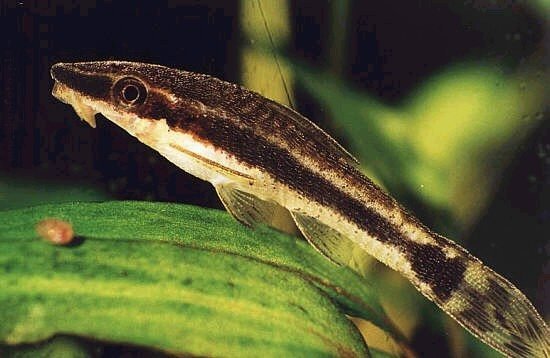
Silver Otocinclus (O. vestitus)
O. vestitus is native to the tributaries of the Ambyiacua River in Peru but is also found in Argentina. It can reach a total length of 3.2 cm.
The Silver Otocinclus has a gray, mottled upper body with a thin horizontal lateral line extending from the mouth to the base of the caudal peduncle.
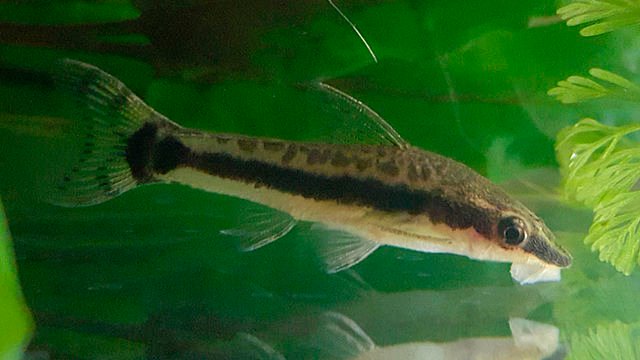
Zebra Otocinclus (O. cocama)
The Zebra Otocinclus is very popular among aquarium enthusiasts. This catfish is endemic to the Peruvian Amazon, specifically the Yanayacu River in the Loreto region (Peru) and a tributary of the Ucayali River in the Ucayali region (Peru).
O. cocama is distinguished from other Otocinclus species by two characteristics: its distinctive color pattern, consisting of vertically elongated blotches extending from the dorsal midline to the ventral edge of the flanks, and a continuous lateral line (Reiss, 2004).
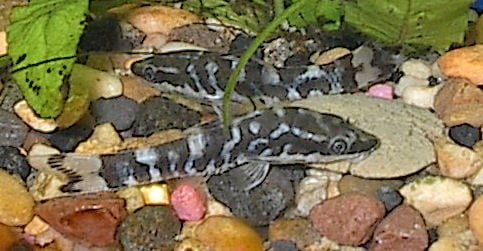
Dwarf Otocinclus (O. macrospilus)
The Dwarf Otocinclus is native to Peru and Colombia. It has a silver and black body coloration.
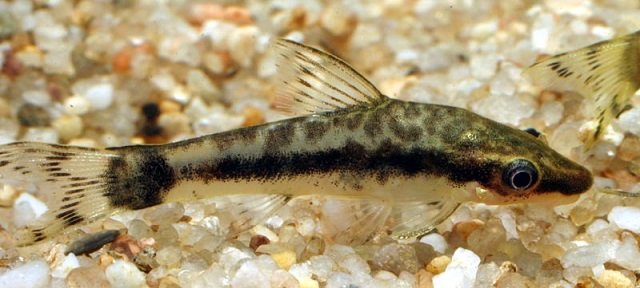
Which is Better?
There is no single answer. O. vittatus is usually the most robust and budget-friendly option for beginners. O. cocama offers a unique aesthetic but may require more pristine conditions and a higher price. The choice will depend on your budget, experience, and aesthetic preferences, but the basic care requirements are very similar for most species.
How to Breed Otocinclus Fish?
Breeding Ottos in home aquariums is possible, but it is neither as common nor as easy as with other fish like guppies or even Corydoras. It requires specific conditions and often happens spontaneously when the fish are extremely comfortable and well-fed.
Otocinclus catfish reach sexual maturity between 6 and 9 months of age. Captive breeding is difficult; however, experts recommend a temperature of 23°C (73°F), a pH of 6.5, and a hardness of 2 to 9 dGH.
Conditions to Induce Spawning
- Healthy, Mature Group: You need an established group with mature males and females in excellent condition.
- Pristine Water Quality: Stable parameters and very clean water are crucial.
- Abundant, Varied Diet: A diet rich in proteins and vegetables can help condition females. Small live foods (such as microworms) can act as a trigger.
- Spawning Triggers: A large water change with slightly cooler water can sometimes simulate the rainy season and stimulate spawning.
- Spawning Surfaces: They prefer to deposit their eggs on smooth surfaces such as aquarium glass, broad plant leaves (Anubias are favorites), or even on the filter.
The Spawning Process and Eggs
Courtship is subtle. Often, a male (or several) will chase a gravid female around the aquarium. The pair will adopt the typical “T-position” seen in many catfish, where the male fertilizes the eggs as the female releases them. The female then deposits the small adhesive eggs individually or in small clusters on the chosen surfaces.
Depending on the species, female Oto lay an average of 65 eggs per spawn, primarily on plants. The eggs hatch in 2 to 4 days.
Otocinclus eggs are very small (around 1 mm), transparent or slightly yellowish, and sticky, making them easy to overlook. They do not lay large amounts at once, usually just a few dozen scattered around the aquarium. Villamil-Moreno & Arias-Castellanos (2011) reported that Otocinclus spectabilis has an average fecundity of 62 ± 8 oocytes per female, with a maximum of 75 oocytes. Additionally, the average diameter of mature oocytes was 1,366.5 ± 203.8 µm.
Egg and Fry Care
Otos parents do not provide parental care and may eat their own eggs or larvae. If you want to raise the fry, it is best to:
- Move the Eggs: Carefully transfer the leaf or gently scrape the eggs off the glass (using an old credit card, for example) and place them in a separate breeding tank with water from the main tank, a soft sponge filter, and possibly a mild antifungal agent (such as methylene blue, used with caution).
- Hatching: The eggs usually hatch in 2–3 days, depending on the temperature.
- Fry Feeding: The larvae will initially consume their yolk sac. Once they swim freely, they need microscopic foods like infusoria, followed by microworms, newly hatched brine shrimp nauplii, and ultra-fine powdered food as they grow. A mature breeding tank with biofilm on the walls is highly beneficial.
Raising Oto fry is delicate and requires dedication.
How to Feed Otocinclus?
One of the leading causes of early mortality in Otocinclus is starvation. It is often mistakenly assumed that they can survive solely on the algae present in the aquarium, which is rarely sufficient in the long run. Understanding and meeting their dietary needs is essential.
Natural Diet: Biofilm and Types of Algae
In the wild, the primary diet of Otocinclus consists of biofilm (a mix of bacteria, diatoms, tiny organisms, and organic matter) and soft algae, such as brown algae (diatoms) and some soft green algae. They are not effective against tougher or filamentous algae like black beard algae (BBA).
Supplementation
A home aquarium—especially a new or very clean one—rarely produces enough biofilm and suitable algae to support a group of Otocinclus. Therefore, regular supplementation is crucial for their survival and well-being.
Types of Food for Otocinclus
- Algae Wafers and Pleco Tablets: Look for high-quality sinking options made primarily with spirulina, chlorella, and other plant-based ingredients. Break large wafers into smaller pieces.
- Fresh Vegetables – They love them! Popular options include:
- Zucchini: Blanched (briefly boiled) and sunk using a plant clip or fork (remove the fork afterward!).
- Cucumber: Treated like zucchini, blanched and sunk.
- Spinach: Blanched.
- Romaine Lettuce: Blanched.
- Peas: Shelled and lightly mashed.
Remove any uneaten vegetables after 24–48 hours to prevent water fouling.
Feeding Frequency and Strategy
- Offer supplemental food several times a week, adjusting frequency based on visible algae and the fish’s condition (look for rounded, not sunken, bellies).
- Feed at night or early in the morning, as they tend to be more active during low-light hours.
- Place the food in the same location consistently so they learn where to find it.
- Observe whether they are actually eating the supplemental food. Some newly introduced Otos (especially wild-caught) may take time to recognize prepared food. Patience and variety are key.
You can also try spreading a bit of Repashy gel food on an Anubias leaf or piece of driftwood so they discover it while grazing.
Otocinclus Care
Caring for Otocinclus catfish is relatively easy if you closely replicate their natural habitat. You should recreate their environment in the aquarium with:
- Substrate: Fine sand.
- Decor: Stones, submerged wood.
- Vegetation: Dense aquatic plants.
Otocinclus are tolerant of a range of water quality parameters; however, this should not be taken for granted. You must remain attentive to their needs. Table 1 provides a technical summary of optimal water parameters for Otos care.
Table 01. Technical Sheet for Otocinclus Care.
| Water Quality Parameter | Range |
|---|---|
| Minimum Aquarium Size | 10 gallons (approximately 40 liters) for a group of 4 to 6 fish |
| Water Temperature | 22 – 26°C (72°F to 79°F) |
| pH | 6.8 – 7.5 |
| Hardness (GH) | 2 – 15 dGH |
| Hardness (KH) | 2 – 12 dKH |
| Nitrates | < 50 mg/L |
| Water Renewal (Volume) | 20 to 30% per month |
Substrate, Plants, and Decoration
An environment that mimics their natural habitat will greatly benefit your Otos.
- Substrate: Fine sand or soft gravel are suitable. Avoid sharp substrates that may damage their delicate mouth and belly.
- Live Plants: Essential! Broad-leaved plants (such as Anubias, Amazon Swords, Cryptocorynes) provide ample surfaces for algae and biofilm growth, as well as offering hiding spots. Stem plants and mosses are also welcome. A densely planted aquarium makes them feel secure.
- Driftwood: Highly recommended. Driftwood releases beneficial tannins (which may slightly tint the water) and provides an excellent surface for biofilm growth, which is a crucial part of their diet.
- Rocks and Caves: Smooth stones and small caves offer additional hiding places and more surfaces for grazing.
Behavior and Compatibility of Otocinclus Fish
Behavior
Otocinclus fish are naturally shy and solitary, swimming fast and seeking to hide quickly when they sense danger. They are passive by nature (Wood, 2022). They will never bother other fish. In fact, they are the ones who can be easily intimidated or stressed by tank mates that are too large, active, or aggressive. They spend most of their time attached to surfaces (glass, leaves, wood, rocks), scraping for food.
Compatibility with Other Aquarium Inhabitants
Given their small size and peaceful nature, choosing tankmates carefully is important.
- Ideal Tankmates: Small, peaceful fish such as Neon Tetras, Cardinals, Danios, Cherry Barbs, Harlequin Rasboras, Pygmy Corydoras, Mollies, Guppies, Pencilfish, Endler’s Guppies, and shrimp (such as Neocaridina or Caridina Japonica).
Tankmates to Avoid:
- Large or aggressive fish (Large Cichlids, Oscars, Jack Dempsey, large Goldfish, etc.).
- Very active or territorial fish that may stress them out or compete aggressively for food (Tiger Barbs, aggressive Bettas in small tanks).
- Other fish that might mistake them for food (Large Angelfish, although sometimes they work if raised together from a young age).
- Crawfish, which may catch them, or freshwater snails.
Always carefully observe interactions when introducing new tankmates.
Conclusion
Otocinclus catfish are much more than just algae cleaners. They require little care, are peaceful, and can help you manage algae in your aquarium (Sheppard, 2022). They are fascinating and delicate fish that, with proper care, can be a charming and lasting addition to a peaceful community tank or a planted aquarium. Understanding their specific needs – from the appropriate tank size and water parameters to their crucial diet and social nature – is key to overcoming initial challenges and enjoying these tireless workers.
While they require more detailed attention than some other aquarium fish, especially during the initial phase, the reward of watching a healthy group of Otos exploring their environment, keeping surfaces clean, and displaying their natural behaviors is well worth the effort. By providing them with a stable home, a varied diet, and the company of their own kind, you will ensure that these little giants of the aquarium world thrive under your care.
References
Edmond Adam. 2022. Otocinclus Catfish – Complete Guide To Care, Breeding, Tank Size, And Diseases. The Aquarium Guide.
Pereira, M. J., & Súarez, Y. R. (2018). Reproductive ecology of Otocinclus vittatus (Regan, 1904) in the Pantanal floodplain, upper Paraguay River basin. Brazilian Journal of Biology, 79, 735-741.
Reis, R. E. (2004). Otocinclus cocama, a new uniquely colored loricariid catfish from Peru (Teleostei: Siluriformes), with comments on the impact of taxonomic revisions to the discovery of new taxa. Neotropical Ichthyology, 2, 109-115.
Rout, J., Sharma, B., Swain, S., & Mishra, S. (2013). Algae in nutrition and colouration of ornamental fish: a review. Renew Sust Energ, 14(2), 578-97.
Satora, L., Kozioł, K., Waldman, W., & Mytych, J. (2019). Differential expression of epidermal growth factor receptor (EGFR) in stomach and diverticulum of Otocinclus affinis (Steindachner, 1877) as a potential element of the epithelium remodeling mechanism. Acta histochemica, 121(2), 151-155.
Sheppard Millie. 2022. Otocinclus Catfish Care: Food, Tank Size, Breeding & More. Aquarium Source.
Villamil-Moreno, L. P., & Arias-Castellanos, J. A. (2011). Fecundidad de Otocinclus spectabilis / Otocinclus spectabilis fecundity. Revista Orinoquia, 15(1), 41-47. https://doi.org/10.22579/20112629.41
Wood Robert. 2022. Otocinclus Care Guide & Species Profile. FishKeeping World.
Editor at the digital magazine AquaHoy. He holds a degree in Aquaculture Biology from the National University of Santa (UNS) and a Master’s degree in Science and Innovation Management from the Polytechnic University of Valencia, with postgraduate diplomas in Business Innovation and Innovation Management. He possesses extensive experience in the aquaculture and fisheries sector, having led the Fisheries Innovation Unit of the National Program for Innovation in Fisheries and Aquaculture (PNIPA). He has served as a senior consultant in technology watch, an innovation project formulator and advisor, and a lecturer at UNS. He is a member of the Peruvian College of Biologists and was recognized by the World Aquaculture Society (WAS) in 2016 for his contribution to aquaculture.
